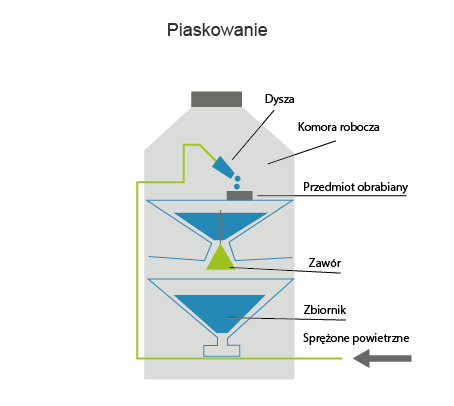Sandblasting (abrasive blasting) is a method of abrasive machining using loose abrasives by the kinetic method. In sandblasting, abrasive grains are propelled in a high-speed fluid (gas, liquid or gas and liquid) stream. The abrasive grains are accelerated by the fluid stream at such a high speed that, despite their low mass, their kinetic energy is sufficient to perform the machining (breaking the cohesion of the workpiece material).

Sandblasting
pl.
Type of technology
Abrasive machining (by means of tools with undefined geometry)
Development phase
Level of innovation
Scale of production
batch, unit
Technology readiness level TRL
Description of the technology
Purpose of use
cleaning, levelling, protecting against corrosion or providing a suitable surface layer condition (e.g. roughness), often used to clean the surface of castings, forgings and objects after heat treatment
Industry usage
machine, automotive, aviation industries
Alternative technologies
- laser cleaning
Visualisation of action
Advantages
- fine cleaning of the surface of components of various dimensions (including very large ones)
- possibility of reconditioning steel components
- improvement of the fatigue strength of the product
- improvement of corrosion resistance
Disadvantages
- negative effects of the abrasive medium on the environment and people
- moderate durability of the sandblasting equipment (due to the dynamic effects of the abrasive particles)
- difficult process conditions for the machine operator
- the need to dispose of the abrasive medium
Workpiece material types
- steel
- non-ferrous metals
- non-ferrous metals alloys
Examples of products
- cleaning of metal structures
- preparation of metal surfaces for further processing
- car bodies
- balustrades
- steel structures
Implementation of the technology
Required resources
- sandblasting machine
- abrasives
Required competences
- training in finish machining
- extensive practical experience in abrasive machining processes
Environmental aspects
Expert evaluation
Development centers
Legal conditions
- none
